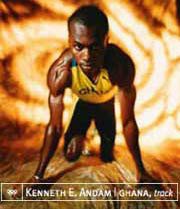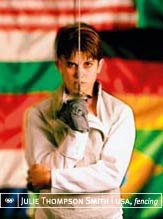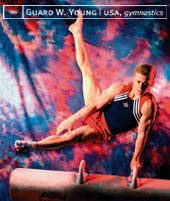By Mary Lynn Johnson
YOU CONCENTRATE on it pretty much every day,” says heptathlete Marsha N. Mark-Baird, ’97, MSW ’99, about training for the 2000 Olympics. “Sometimes just going to work, I’ll be thinking about the high jump and my approach. My husband gets really embarrassed because we’re in the grocery store and I’m doing long jump approaches through the aisles. And he’s like, ‘Honey, people are staring.’ I say, ‘I know, but that’s just my way of focusing.'”
This summer, training for the Olympics has dominated the minds—and lives—of more BYU athletes than ever before. More than 20 BYU students and alums qualified for the U.S. Olympic trials this year, and at least seven BYU-trained athletes will represent other countries at the 2000 Summer Games, scheduled for Sept. 15 to Oct. 1 in Sydney, Australia.
Mark-Baird, for instance, holds the fourth-best heptathlon score in BYU history, and she will compete for Trinidad and Tobago at the Olympics. A gang preventionist for the Provo School District, she spent the summer training—on campus, six afternoons a week—with two other alumna heptathletes, Americans Alicia K. Brimhall, ’99, and Tiffany D. Lott-Hogan, ’98.
A 10-time All-American and two-time NCAA champion in the heptathlon, Lott-Hogan has the world’s fastest time in the 55-meter hurdles. She qualified for the 1996 Olympic trials but couldn’t compete because of a knee injury. Since then, she says, her training has been focused on “trying to get back, so I could make it to this Olympics.” She placed fourth at the U.S. trials, just missing an Olympic berth; Brimhall placed 15th.
Record Numbers
BYU‘s Olympic history began with Alma W. Richards, the Brigham Young Academy high jumper from Parowan, Utah, who won a gold medal at the 1912 Olympics. The most recent BYU-linked Olympic medals came in 1996 in Atlanta, where Frank Fredericks, ’91, MBA ’94, representing Namibia, repeated his 1992 performance and won silver medals in both the 100-meter and 200-meter sprints. In the 80 years between Richards and Fredericks, BYU trained dozens of other Olympians and several more medalists—notably Yugoslavian basketball great Kresimir Cosic, who won medals at four consecutive Games (1968–1980).
This year, BYU‘s women tracksters were more than half of the story—an unprecedented 16 of them qualified for the U.S. trials July 14–23 in Sacramento, Calif. In contrast, only three BYU women qualified for the track and field trials in 1996. Those three—Lott-Hogan, distance runner Courtney L. Pugmire Meldrum, and thrower Amy M. Christiansen Palmer, ’99—were back in 2000, and this time they had plenty of company.
But while track and field athletes made up the majority of BYU‘s Olympic hopefuls, other Cougars (present and former) trained this summer in the swimming pool, on the volleyball court, and even with a fencer’s foil.
Fencer Julie Thompson Smith, ’96, discovered her talent for the sport during her first year at BYU, by default. “I tried out for the BYU softball team and was cut,” she explains. “So I was looking for something to do.” She took fencing only because all the clogging classes were full.
That was in 1991, and Smith qualified for national competition in 1993. When Olympic decisions were made, she ranked fifth in the nation with a foil, the traditional fencing weapon. And four women fencers make up the U.S. team. “This year we have the strongest fencing team that we’ve ever had in the United States,” she says. “So for me to even be in the running is really exciting.”
Leaps of Faith
For athletes from small countries, one performance at their nation’s qualifying level can guarantee an Olympic berth. “When I got the standard I was jumping around the whole night, not even sleeping at all,” says Maggie M. Chan, ’00, who will run the 5,000 meters for Hong Kong.
But in larger countries like the United States and Canada, meeting the standard is what qualifies an athlete for the Olympic trials. And in track and field events, for example, only the top three scorers from the trials make the U.S. Olympic team. That one-meet, all-or-nothing pressure means that top-ranked athletes can take nothing for granted—and that long-shot athletes have a chance. Whatever his or her past record, when an athlete joins the ranks of Olympic hopefuls, it’s always a leap of faith.
Willard M. Hirschi knows a bit about the faith required to compete on an Olympic level. Recently retired as BYU‘s head men’s track coach, he has coached BYUathletes at two previous Olympics. “Those who succeed have faith,” he says. “It isn’t necessarily a spiritual faith, but it is a kind of faith—a belief in themselves and a belief that the coaches know what they’re talking about.”
This year Hirschi coached several potential Olympians, including Kenneth E. Andam, a senior from Takoradi, Ghana. In May, newly recovered from a stress fracture, Andam ran 100 meters in 10.13 seconds, a new personal best that lifted him to the third-fastest time in BYU history, behind Leonard Myles-Mills, ’99, and Frank Fredericks—who will both be running in Sydney.
Taking cues from more experienced runners is important to Andam as he anticipates his first Olympics. With any race, he says, “I run it in my head a couple times, looking at all the top sprinters in the world and thinking of what they’ll be doing. How would Carl Lewis want to get out of the blocks and run this race? And then I convince myself that I’m capable of doing that.”
Striving for a new personal best epitomizes the preparation of all Olympic hopefuls. Runner Susan L. Taylor, for instance, set a new BYU record when she ran the 1500 meters in 4:13:03 at the 2000 NCAA championships. Throughout the season, she says, “I just had this momentum where I kept getting better and better.” Breaking her record at the championships “was really a special feeling,” she says. “And it wasn’t just about the glory of winning. It’s a good feeling to finally do what you had been expecting of yourself for a long time.” The record put her in a stronger position for the Olympic trials, where she placed 11th. And Taylor, a senior who has finished her college eligibility, admits that it has changed her perspective about training after college. “I love getting better, and I love competing,” she says. “You just want to push yourself higher and higher and see how good you can get.”
Trials Tribulations
When Courtney Pugmire Meldrum won the 3000-meter steeplechase at the 1996 Olympic trials, she was only 19 and had just finished her freshman year at BYU. At the trials, awed at being in the same stadium with experienced, world-class runners, she remembers thinking, “I’m going to kill my coach for bringing me here.” When the national anthem played before her race, she says, “I seriously wanted to run the other way and hide.”
But the other athletes were kind, she says. Some assured her, “‘It’s OK, honey’—they could tell I wanted to cry. And then after I won they were like, ‘What were you whining about?’ And I said, ‘I’m sorry. I didn’t know what I was doing.'”
This time she does. “So much of running is good experience,” explains Meldrum, now a BYU senior. But she insists that, having just returned from a year-long maternity leave, she’s not the front-runner. At the 2000 trials Meldrum ran with a cadre of teammates: four BYU women competed in the steeplechase, and all four of them finished in the top five. None of them will run in Sydney, however, because the women’s steeplechase won’t be an official Olympic event until 2004.
One of the BYU women who will represent the United States in Sydney is thrower Amy Christiansen Palmer, an eight-time All American who holds BYU records in the hammer throw and the shot put. At the 1996 trials she placed fifth in the shot put. This year, ranked second in the U.S. and 6th in the world in the women’s hammer throw, she was confident about making the Olympic team.
Palmer has trained continually since the 1996 trials. While staying at the top of the rankings for four years is tough, it does give her a mental edge. “You feel good knowing that you’re right up there and everyone’s watching to see what you’re doing,” she says. “You have extra confidence going into the big meets.”
Getting There
“I’ve always had the Olympics as a goal,” says Guard W. Young, whose father, Wayne, competed as a gymnast in the 1976 Olympics. “But it’s never been a realization until last year.” After finishing eighth in the all-around competition at the 1999 NCAA championships, he says, “I knew how close I was.”
Young took second at the 2000 NCAAs, and this summer he put in “lots of numbers. I have a complete schedule all mapped out up to the Olympic trials of how many routines I do each day.”
Since his final meets were Aug. 17–19, after most other Olympic trials, Young was one of the last BYU qualifiers to find out if he had made an Olympic team. Though he placed 10th, a few spots away from making the 7-member squad, Young says, “You have to enjoy the process of getting there. That’s what it’s all about—the process of getting to the Olympic trials and being at that level to compete.”









